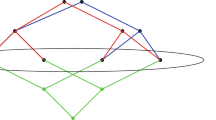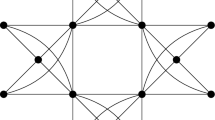Abstract
We prove upper bounds on the graph diameters of polytopes in two settings. The first is a worst-case bound for polytopes defined by integer constraints in terms of the height of the integers and certain subdeterminants of the constraint matrix, which in some cases improves previously known results. The second is a smoothed analysis bound: given an appropriately normalized polytope, we add small Gaussian noise to each constraint. We consider a natural geometric measure on the vertices of the perturbed polytope (corresponding to the mean curvature measure of its polar) and show that with high probability there exists a “giant component” of vertices, with measure \(1-o(1)\) and polynomial diameter. Both bounds rely on spectral gaps—of a certain Schrödinger operator in the first case, and a certain continuous time Markov chain in the second—which arise from the log-concavity of the volume of a simple polytope in terms of its slack variables.

Similar content being viewed by others
References
Alexandrov, A.D.: Zur theorie der gemischten volumina von konvexen körpern ii. Mat. Sbornik N.S. 2, 1205–1238 (1937)
Alexandrov, A.D.: Zur theorie der gemischten volumina von konvexen körpern iv. Mat. Sbornik N.S. 3, 227–251 (1938)
Anari, N., Liu, K., Gharan, S.O., Vinzant, C.: Log-concave polynomials II: high-dimensional walks and an FPRAS for counting bases of a matroid. In: STOC’19—Proceedings of the 51st annual ACM SIGACT symposium on theory of computing (pp. 1–12). ACM, New York (2019)
Barnette, D.: An upper bound for the diameter of a polytope. Discret. Math. 10, 9–13 (1974)
Bonifas, N., Di Summa, M., Eisenbrand, F., Hähnle, N., Niemeier, M.: On sub-determinants and the diameter of polyhedra. Discrete Comput. Geom. 52(1), 102–115 (2014)
Borgwardt, K., Huhn, P.: A lower bound on the average number of pivot-steps for solving linear programs valid for all variants of the simplex-algorithm. Math. Methods OR 49, 175–210 (1999)
Borgwardt, K.-H.: Untersuchungen zur Asymptotik der mittleren Schrittzahl von Simplexverfahren in der linearen Optimierung. In: 2nd Symposium on Operations Research (Rheinisch-Westfälische Tech. Hochsch. Aachen, Aachen, 1977), Teil 1, Operations Res. Verfahren, XXVIII, pp. 332–345. Hain, Königstein/Ts (1978)
Borgwardt, K.-H.: The Simplex Method. Algorithms and Combinatorics: Study and Research Texts, vol. 1. Springer, Berlin (1987). A probabilistic analysis
Brunsch, T., Röglin, H.: Finding short paths on polytopes by the shadow vertex algorithm. In: Automata, Languages, and Programming. Part I. Lecture Notes in Computer Sciences, vol. 7965, pp. 279–290. Springer, Heidelberg (2013)
Chung, F.R.K.: Diameters and eigenvalues. J. Am. Math. Soc. 2(2), 187–196 (1989)
Dadush, D., Hähnle, N.: On the shadow simplex method for curved polyhedra. Discrete Comput. Geom. 56(4), 882–909 (2016)
Dadush, D., Huiberts, S.: A friendly smoothed analysis of the simplex method. SIAM J. Comput. (2020). https://doi.org/10.1137/18M119720
Deshpande, A., Spielman, D.A.: Improved smoothed analysis of the shadow vertex simplex method. In 46th Annual IEEE Symposium on Foundations of Computer Science (FOCS’05), pages 349–356 (2005)
Dyer, M., Frieze, A.: Random walks, totally unimodular matrices, and a randomised dual simplex algorithm. Math. Program. 64(1, Ser. A), 1–16 (1994)
Eisenbrand, F., Vempala, S.: Geometric random edge. Math. Program. 164(1–2, Ser. A), 325–339 (2017)
Grimmett, G.R., Stirzaker, D.R.: Probability and Random Processes. Oxford University Press, Oxford (2020). 4th edn [of 0667520]
Izmestiev, I.: The Colin de Verdière number and graphs of polytopes. Isr. J. Math. 178, 427–444 (2010)
Kalai, G., Kleitman, D.J.: A quasi-polynomial bound for the diameter of graphs of polyhedra. Bull. Am. Math. Soc. (N.S.) 26(2), 315–316 (1992)
Larman, D.G.: Paths of polytopes. Proc. Lond. Math. Soc. 3(20), 161–178 (1970)
McMullen, P.: On simple polytopes. Invent. Math. 113, 419–444 (1993)
McMullen, P.: Weights on polytopes. Discrete Comput. Geom. 15, 363–388 (1996)
Mihail, M.: On the expansion of combinatorial polytopes. In: Mathematical Foundations of Computer Science 1992 (Prague, 1992). Lecture Notes in Computer Science, vol. 629, pp. 37–49. Springer, Berlin (1992)
Naddef, D.: The Hirsch conjecture is true for \((0,1)\)-polytopes. Math. Program. 45(1, (Ser. B)), 109–110 (1989)
Narayanan, H., Shah, R., Srivastava, N.: A spectral approach to polytope diameter. arXiv preprint (2021). arXiv:2101.12198
Santos, F.: A counterexample to the Hirsch conjecture. Ann. Math. 176(1), 383–412 (2012)
Schneider, R.: Polytopes and Brunn–Minkowski theory. In: Polytopes: Abstract, Convex and Computational (Scarborough, ON, 1993). NATO Advanced Study Institute, Nonstandard Analysis and Its Applications, vol. 440, pp. 273–299. Kluwer, Dordrecht (1994)
Schneider, R.: Convex Bodies: The Brunn–Minkowski Theory. Encyclopedia of Mathematics and Its Applications, vol. 151, expanded edn. Cambridge University Press, Cambridge (2014)
Sokal, A.D., Thomas, L.E.: Absence of mass gap for a class of stochastic contour models. J. Stat. Phys. 51(5), 907–947 (1988)
Spielman, D.A., Teng, S.-H.: Smoothed analysis of algorithms: why the simplex algorithm usually takes polynomial time. J. ACM 51(3), 385–463 (2004)
Stanley, R.P.: The numbers of faces of a simplicial convex polytope. Adv. Math. 35, 236–238 (1980)
Sukegawa, N.: An asymptotically improved upper bound on the diameter of polyhedra. Discrete Comput. Geom. 62(3), 690–699 (2019)
Timorin, V.A.: An analogue of the Hodge–Riemann relations for simple convex polyhedra. Uspekhi Mat. Nauk, 54(2(326)), 113–162 (1999)
Todd, M.J.: An improved Kalai–Kleitman bound for the diameter of a polyhedron. SIAM J. Discret. Math. 28(4), 1944–1947 (2014)
Van Dam, E.R., Haemers, W.H.: Eigenvalues and the diameter of graphs. Linear Multilinear Algebra 39(1–2), 33–44 (1995)
Vershynin, R.: Beyond Hirsch conjecture: walks on random polytopes and smoothed complexity of the simplex method. SIAM J. Comput. 39(2), 646–678 (2009)
Acknowledgements
We thank Daniel Dadush, Bo’az Klartag, and Ramon van Handel for helpful comments and suggestions on an earlier version of this manuscript. We thank Ramon van Handel for pointing out the important reference [17]. We thank the IUSSTF virtual center on “Polynomials as an Algorithmic Paradigm” for supporting this collaboration.
Author information
Authors and Affiliations
Corresponding author
Additional information
Editor in Charge: Kenneth Clarkson
Publisher's Note
Springer Nature remains neutral with regard to jurisdictional claims in published maps and institutional affiliations.
There is no data associated with this manuscript. Supported by a Swarna Jayanti fellowship
Rights and permissions
Springer Nature or its licensor (e.g. a society or other partner) holds exclusive rights to this article under a publishing agreement with the author(s) or other rightsholder(s); author self-archiving of the accepted manuscript version of this article is solely governed by the terms of such publishing agreement and applicable law.
About this article
Cite this article
Narayanan, H., Shah, R. & Srivastava, N. A Spectral Approach to Polytope Diameter. Discrete Comput Geom (2024). https://doi.org/10.1007/s00454-024-00636-y
Received:
Revised:
Accepted:
Published:
DOI: https://doi.org/10.1007/s00454-024-00636-y




